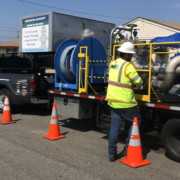Sweetwater Authority Secures Additional Water for Customers Through Controlled Transfer Between Reservoirs
Chula Vista, Calif. – In order to secure additional water supply for our customers, Sweetwater Authority initiated a controlled transfer of water between its two reservoirs on January 26, 2023.
“Late December and January brought substantial rainfall to the region,” said General Manager Carlos Quintero. “However, after four years of dry weather patterns, we are still in need of water. Sweetwater Reservoir is below 40 percent capacity. These transfers are standard operational practices that we conduct to secure the water supply for our customers.”
Water that leaves Loveland Reservoir is transferred through the Sweetwater River channel and captured at Sweetwater Reservoir where it can be treated and distributed to Authority customers at a lower cost than importing water. Recent rainfall and saturated soils have created optimal conditions for the transfer. The Authority anticipates capturing approximately 3,500 acre-feet of water with the transfer. This equates to a savings of approximately $5 million in costs associated with purchasing imported water.
A similar water transfer was last initiated in November 2022. That transfer captured approximately 4,000 acre-feet of water, saving Authority customers more than $6.2 million. Additional runoff will continue to flow in the Sweetwater Reservoir once the transfer is completed from subsequent storms this winter. The Authority expects that after this transfer, there will be sufficient water stored behind Sweetwater Reservoir to provide an adequate supply for over one year. The Authority will monitor the water transfer, which will occur over several weeks, and make modifications as necessary depending on weather conditions.
The Authority worked closely with local landowners and businesses near the Sweetwater River channel, notifying them by mail and phone prior to the start of the transfer to lessen any potential impacts. The Authority conducts controlled transfers periodically and coordinates with the U.S. Fish and Wildlife Service to ensure that environmental needs are met.




